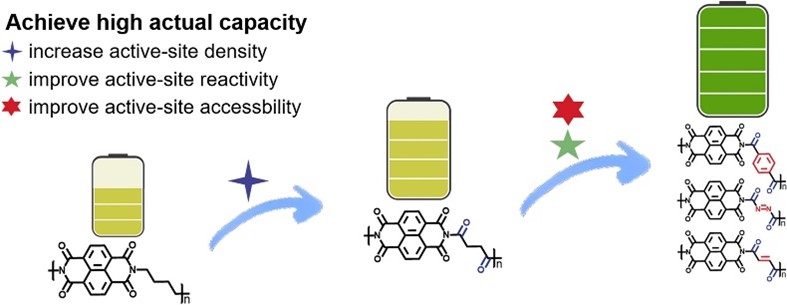
Unlocking high-performance potential: polyimide materials for next-generation batteries

Enhancing Lithium-Ion Batteries through Polyimide Optimization.
GA, UNITED STATES, February 7, 2025 /EINPresswire.com/ -- A new study has unveiled a new strategy to enhance lithium-organic batteries by optimizing the active-site density, accessibility, and reactivity in polyimide cathode materials. This innovative approach offers the potential for batteries with higher capacity, faster charge rates, and improved cycling stability—pushing the boundaries of sustainable energy storage technology.
Organic electrode materials are celebrated for their sustainability and adaptability, making them promising candidates for next-generation energy storage systems. However, challenges such as limited active-site density and inefficient utilization have impeded their practical application. Addressing these hurdles requires a deeper understanding of how molecular structure impacts electrochemical performance—an area where significant progress is now being made.
Published (DOI: 10.1016/j.esci.2023.100224) on August, 2024, in eScience, this innovative research was led by scientists from Jilin University and the Chinese Academy of Sciences. Through the design and evaluation of five distinct polyimide structures, the team demonstrated how incorporating carbonyl and conjugated structures can transform lithium-ion battery performance, providing a roadmap for future advancements.
The researchers synthesized and tested five polyimides—PTN, PAN, PMN, PSN, and PBN—each engineered with distinct molecular modifications to improve performance. Introducing carbonyl groups significantly increased active-site density, creating more redox-active sites and boosting theoretical capacity. Enhanced molecular rigidity proved critical for better accessibility, preventing excessive stacking and optimizing electrochemical interactions. Among the designs, PTN emerged as a standout, demonstrating the highest capacity (212 mAh g⁻¹ at 50 mA g⁻¹), exceptional stability, and superior rate performance. Furthermore, conjugated structures between carbonyl groups enhanced the reactivity of active sites, enabling efficient charge transfer and stabilizing radical intermediates. All polyimides displayed impressive cycling stability, with capacity retention rates exceeding 97% across extended use, showcasing the robustness of this molecular engineering approach. These findings illuminate new pathways for designing high-performance organic electrode materials.
Professor Hongyan Yao, the study's lead researcher, stated, “This research highlights how strategic molecular design can fundamentally enhance electrochemical properties. By focusing on structure-function relationships, we have opened the door to more sustainable and efficient energy storage solutions that meet the demands of modern applications.”
This breakthrough has profound implications for the future of lithium-ion battery technology. The advanced polyimide cathodes are well-suited for applications in portable electronics, electric vehicles, and large-scale energy grids. By addressing key limitations of organic cathodes, this study contributes to the global transition toward cleaner and more efficient energy systems, setting the stage for innovations that support a greener and more sustainable future.
DOI
10.1016/j.esci.2023.100224
Original Source URL
https://doi.org/10.1016/j.esci.2023.100224
Funding information
The authors thank the financial support from the National Natural Science Foundation of China (No. 51903100) and the Science and Technology Development Plan of Jilin Province, P. R. China (No. 20210402060GH and 20230201138GX).
Lucy Wang
BioDesign Research
email us here
Distribution channels: Science, Technology
Legal Disclaimer:
EIN Presswire provides this news content "as is" without warranty of any kind. We do not accept any responsibility or liability for the accuracy, content, images, videos, licenses, completeness, legality, or reliability of the information contained in this article. If you have any complaints or copyright issues related to this article, kindly contact the author above.
Submit your press release